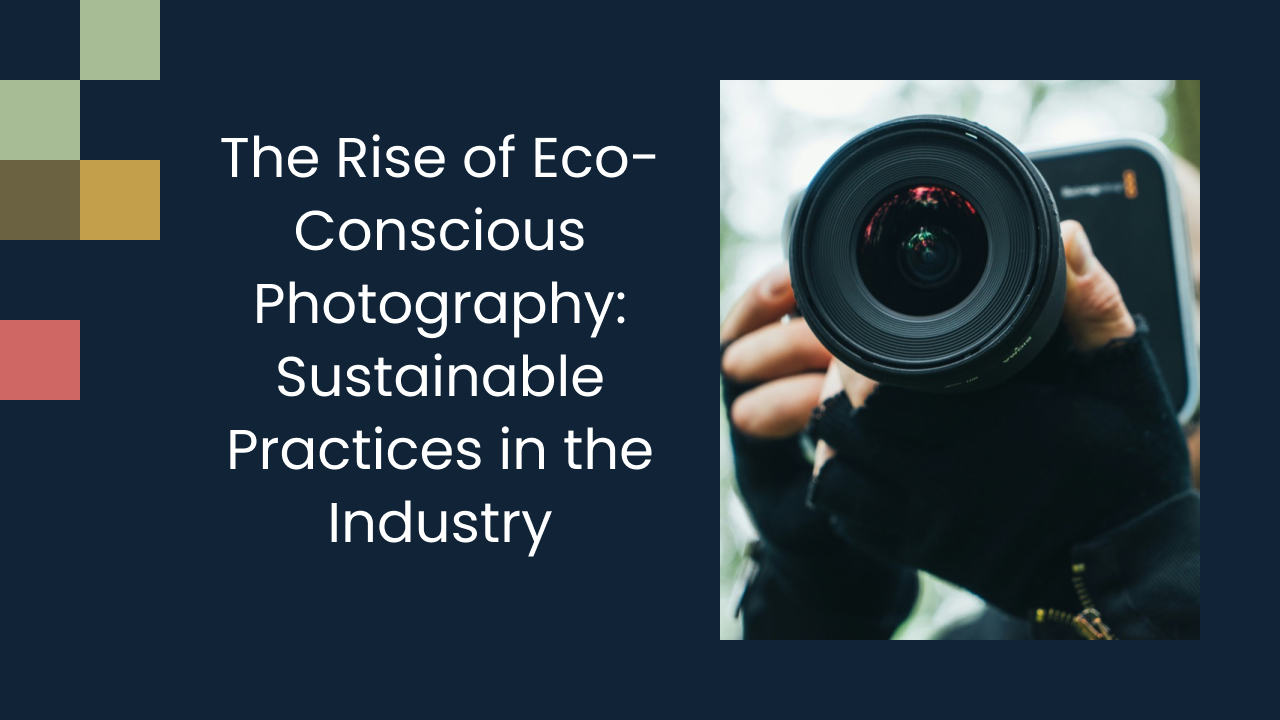The Rise of Eco-Conscious Photography: Sustainable Practices in the Industry

In recent years, there has been a significant rise in awareness and adoption of eco-conscious practices in various industries. Photography, being an influential medium with a global reach, has also witnessed a shift towards sustainability. This article explores the emergence of eco-conscious photography and its impact on the industry.
Understanding Eco-Conscious Photography
Before we delve into the specifics, it is important to define what eco-conscious photography entails. Simply put, it refers to the practice of capturing and creating images while minimizing harm to the environment. This involves reducing the ecological footprint associated with various aspects of photography, such as equipment, processing, and printing.
The Importance of Sustainability in Photography
As the world grapples with environmental challenges, sustainability has become a key concern in every sector, including photography. The photography industry holds immense power to shape societal perceptions and evoke emotions through visuals. Hence, adopting sustainable practices in photography is crucial to address environmental issues and promote a greener future.
One of the fundamental principles of eco-conscious photography is the concept of "leave no trace." This principle emphasizes the importance of leaving natural environments exactly as they were found, without any impact from the photography process. This involves respecting wildlife habitats, minimizing disturbances, and refraining from leaving behind any waste or litter.
Furthermore, eco-conscious photographers often opt for digital photography over traditional film methods. Digital photography significantly reduces the environmental impact by eliminating the need for harmful chemicals used in film development and reducing paper waste from prints. Additionally, digital files can be stored and shared electronically, further minimizing the use of physical resources.
The Shift Towards Sustainable Photography
The increasing awareness about environmental issues and the desire for sustainable living have been instrumental in driving the shift towards eco-conscious photography. However, various factors have contributed to this change:
- Consumer Demand: Informed consumers are increasingly seeking products and services that align with their eco-friendly values. This demand has urged photographers and businesses to adopt sustainable practices to cater to their clientele.
- Technological Advancements: The advancement of technology has provided photographers with more options for eco-friendly equipment and processes. This has made sustainable photography more accessible and feasible in terms of cost and efficiency.
- Regulatory Pressures: Governments and regulatory bodies are implementing stricter environmental regulations. This has pushed the photography industry to adopt sustainable practices to comply with these requirements.
Despite the positive momentum, there are several challenges that photographers face in adopting sustainable practices:
- Cost Considerations: Sustainable equipment and processes often come with a higher price tag, posing a financial barrier for many photographers.
- Educational Gap: There is a need for education and awareness about sustainable photography practices. Many photographers are not aware of the available options or the impact their choices can have.
- Resistance to Change: Like any change, transitioning to sustainable practices requires overcoming resistance and embracing new ways of operating. This can be a challenging process for some photographers.
However, despite these challenges, the shift towards sustainable photography is gaining momentum, with photographers and industry leaders taking innovative steps to make a positive impact on the environment.
One such step is the development of eco-friendly camera equipment. Companies are now designing cameras and lenses that are made from recycled materials and have reduced carbon footprints. These eco-friendly cameras not only help photographers reduce their environmental impact but also provide them with high-quality tools to capture stunning images.
Another aspect of sustainable photography is the adoption of renewable energy sources. Photographers are increasingly using solar-powered charging stations for their equipment, reducing their reliance on traditional energy sources and minimizing their carbon emissions during shoots.
Sustainable Practices in Photography
To minimize their environmental footprint, photographers can adopt a range of sustainable practices:
Photography is a creative and impactful medium that allows individuals to capture moments and tell stories. However, the process of creating images can have a significant environmental impact. By embracing sustainable practices, photographers can reduce their carbon footprint and contribute to a greener future for the planet.
Environmentally Friendly Equipment
Choosing eco-friendly equipment can significantly reduce the impact of photography on the environment. Opting for cameras and accessories that are made from recycled materials or have lower energy consumption can make a difference. Additionally, investing in gear that is durable and long-lasting can help minimize electronic waste and promote a more sustainable industry.
Furthermore, exploring alternative energy sources such as solar-powered chargers for camera batteries or using rechargeable batteries can further enhance the eco-friendliness of photography equipment. By making conscious choices about the tools they use, photographers can align their passion with environmental stewardship.
Sustainable Processing and Printing Techniques
The processing and printing stages of photography also offer opportunities for sustainability. Using energy-efficient machines, recycling chemicals, and sourcing eco-friendly printing materials are some measures photographers can take. Additionally, opting for digital formats and online sharing platforms can reduce the need for physical prints, saving resources and reducing waste.
Moreover, photographers can explore innovative techniques such as cyanotype printing, which uses sunlight to develop images on specially coated paper, eliminating the need for traditional printing processes that consume large amounts of energy and water. Embracing these sustainable processing and printing methods can not only benefit the environment but also inspire creativity and experimentation in photography.
The Impact of Eco-Conscious Photography
Eco-conscious photography can have significant benefits for the environment as well as the industry:
Photographers who prioritize eco-conscious practices not only contribute to the preservation of the environment but also set an example for others in the industry to follow. By using biodegradable packaging, opting for energy-efficient equipment, and supporting eco-friendly suppliers, these photographers actively reduce their carbon footprint and promote sustainability in their work.
Benefits to the Environment
By adopting sustainable practices, photographers can help reduce pollution, minimize waste generation, and conserve natural resources. This, in turn, contributes to the overall efforts of mitigating climate change and preserving biodiversity.
Furthermore, eco-conscious photography often involves capturing images that raise awareness about environmental issues. Through their work, these photographers can shine a light on pressing ecological concerns, prompting viewers to reflect on the beauty of nature and the urgent need to protect it.
Influence on the Global Photography Industry
The adoption of eco-conscious practices by photographers has the potential to inspire others within the industry. The influence of sustainable photography can extend beyond individual photographers or businesses and create a larger shift in mainstream practices.
As more photographers embrace eco-friendly techniques, the demand for sustainable photography services is likely to increase. This shift can lead to a transformation in the photography industry, encouraging a widespread adoption of environmentally responsible practices and fostering a culture of sustainability among professionals and consumers alike.
The Future of Eco-Conscious Photography
The growth of eco-conscious photography is likely to continue, with emerging trends and evolving roles for photographers:
Emerging Trends in Sustainable Photography
As technology advances, we can expect to see innovations that offer even more sustainable solutions for photographers. This may include the development of eco-friendly materials, energy-efficient equipment, and improved recycling and disposal methods.
Furthermore, another emerging trend in sustainable photography is the concept of upcycling. Photographers are finding creative ways to repurpose old equipment or materials to reduce waste and minimize their environmental impact. This not only showcases their commitment to sustainability but also adds a unique and artistic touch to their work.
The Role of Photographers in Promoting Sustainability
Photographers have a unique position to raise awareness about environmental issues and promote sustainable lifestyles. They can use their images to tell compelling stories and evoke emotions that drive positive change in individuals and society as a whole.
Moreover, photographers can collaborate with environmental organizations and non-profits to document and highlight conservation efforts, climate change impacts, and sustainable practices around the world. By partnering with these groups, photographers can amplify their message and reach a wider audience, inspiring more people to take action towards a greener and more sustainable future.
In conclusion, the rise of eco-conscious photography signifies a significant shift towards sustainable practices in the industry. Through understanding the importance of sustainability, embracing eco-friendly equipment and processes, and recognizing the impact of photography on the environment, photographers can play a crucial role in shaping a greener future.
Looking for an easier way to manage and grow your studio? Experience a platform built by a photographer, for photographers. Try it free for 2 weeks.











